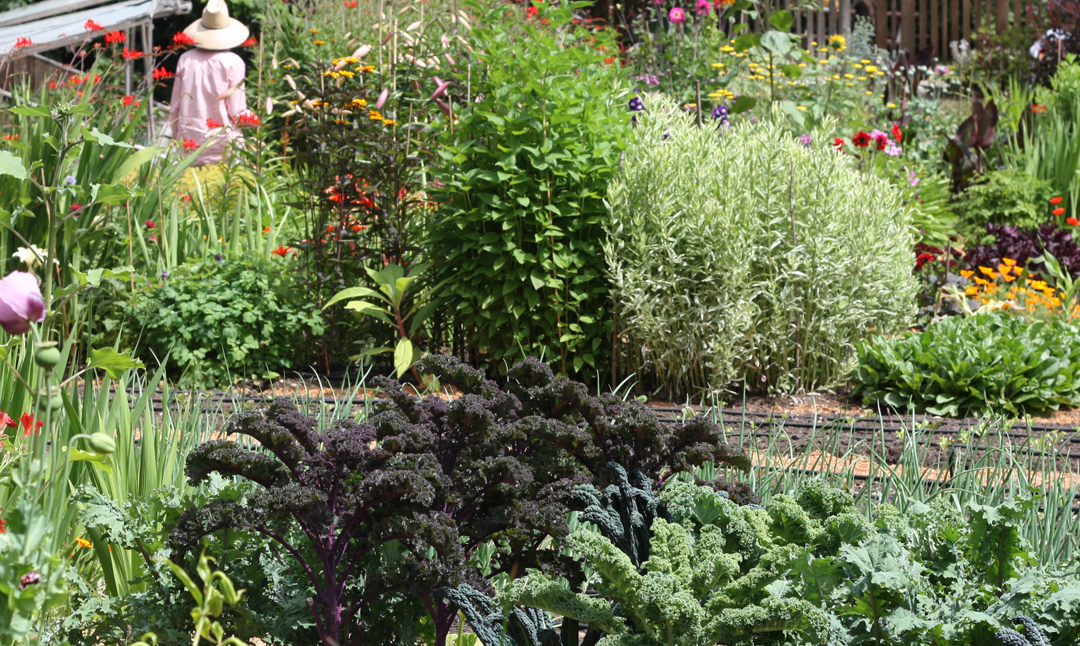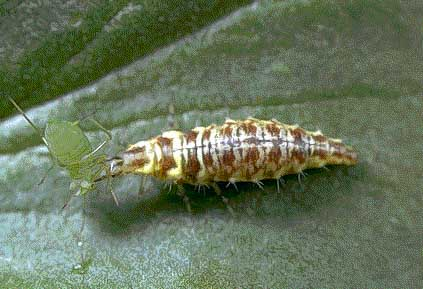Adding flowering perennials to your annual garden, will attract beneficial insects and build resilience to pests. By creating a home for the ‘good guys’, you not only build biodiversity, but brighten up a monochromatic green space.

With some tweaks to your garden plan, and a few extra plants, you should see more of these helpful insects in about 6 months:
- ladybugs
- parasitic wasps (non-stinging)
- hoverflies
- praying mantids
- lacewings
- tachinid flies
Making changes to the very life that sustains your garden does take some time. And it can be a little frustrating at first to see the odd plant attacked by predators. Yet, these bugs are crucial food and an integral part of our grand plan (keep reading).
You’re right in thinking that patience is the key. Fear not friends, the payoff is worth it, with less time and money spent in the long-term making and applying organic quick-fixes. Say goodbye to neem oil, soap blends and insecticidal powders.
P.S beware of diatomaceous earth. Although ‘organic’ it is an indiscriminate killer of both the bad AND the good insects.
Before I go any further, it’s important to note that in general, insects do not attack plants to spite us. Insects are nature’s decomposers. They are here in part to break down unhealthy or dying plants into further mulch and soil. So, we must ask ourselves, “Why is the plant attracting pests in the first place?”
This questionnaire should help identify the cause of any such unwanted attention:
- Is the plant getting too much sun or shade?
- Are there any bad companion plants nearby that allelopathic (eg locust or walnut tree) or competing for resources?
- Is soil drainage or water retention an issue/is the soil too wet, or too dry?
- Is the plant suited to this climate or are conditions being provided (eg more shade or water) to make it more comfortable in this climate?
- Is it a pest/disease resistant plant variety? Increasingly you can find varieties (eg lettuce and cilantro) that have been developed to delay bolting in warmer climates.
So how do we begin?
The main goal is to tempt our insect friends into calling your garden ‘home’. Providing some food and shelter will make for a cozy inn away from the cold, so to speak.
Certain beneficial insects are better at managing certain pests than others. To attract these insects, choose plants whose design makes it easy for them to reach and feed on the nectar. For example, because lacewings, hoverflies and ladybugs have short mouth parts, they can only feed on small, shallow flowers, like those found in the Umbelliferae family.
These insects like making a meal out of aphids (yay!), so it makes sense to attract them with ‘Umbels’ such as dill, fennel, carrot, parsley and coriander.
It’s worth noting that it’s the larvae of these insects that destroy many of the pests. The larvae look completely different from the adults, so you will need to keep a keen eye out for the no-so-little dudes.

Which plants should I use?
My favourite flowering perennial to plant is yarrow. It’s not only beautiful but also medicinal, available in many colours, and the nursery varieties don’t self-seed. Besides those mentioned above, other edible ‘Umbels’ include caraway, cumin, lovage and chervil.
Fennel and dill will cross-pollinate, so either choose just one of these to plant, or plant them in opposite corners of the yard (dill-tasting fennel is pretty gross, especially if you plan to use those fennel seeds in a lovely chai tea blend!).
I prefer to choose plants that can provide more than one function. Edible perennials and self-seeding annuals that also attract beneficial insects include:
- lavender
- bergamot
- lemon balm (self-seeding)
- spearmint (keep any mints in pots to prevent them taking over the garden)
- anise hyssop (great when dried for tea)
Whichever plants you decide on, be sure to plant many different varieties that can provide constant flowers ideally from early spring to late fall. In addition to planting flowering perennials, there are a few other techniques you can use to deter insect pests:
- Add a bird bath or fountain to attract birds and other beneficials
- If space allows, plant in clumps of 3; this will attract more beneficial insects and look great too
- Avoid planting only one variety of vegetable in the same bed. Mixing up the varieties and dispersing them across multiple garden beds, will make pests work harder to find the other plants
- Adding a few smaller flowering perennials in the same bed as annual crops will bring the beneficial insects right where you need them.
Another way to reduce pest damage is by confusing the insects. For example, you can distract the carrot rust fly and save the entire row of carrots from decimation by:
1. Not sowing seeds in rows
2. Creating a patchwork of annuals combined with specific flowering perennials
This of course should be done in combination with other techniques integral to crop health such as crop rotation. Hence the need for a garden plan.

How does this affect how I irrigate?
For more particular crops like carrots and lettuce, I recommend setting up one or two beds that allow for consistent watering. An effective irrigation design for a raised bed is to place micro-sprayers around the inner edge. You can reduce water evaporation by mulching in between the rows.
Grass clippings are my favourite mulch for a garden bed. They are free, contain 5% Nitrogen, and unlike bark-rich compost or mulch, rarely attract pill bugs.
If you already have a pollinator garden that uses a low water DRIP system, then try integrating a few patches of annual plants. Yes, there are only a few veggies that can work in this low-water situation, and so far I’ve found kale, nasturtium, runner beans, and tomatoes and peppers (when mulched on top), to thrive without any insect damage.
Bear in mind, like many greens grown in the Okanagan, kale and nasturtium will do best in partial shade.
I hope you find these tips useful in your garden planning this season. For more details, insect images, and a handy reference chart, check out this quick guide provided by Oregon State University.
Feel like Zen-ing out with plants on the big screen? Although the image quality from ’95 isn’t super, I still recommend watching David Attenborough’s The Private Life of Plants (episode links provided in the December newsletter). The Flowering episode is particularly good and highlights why and how flowers attract insects.
